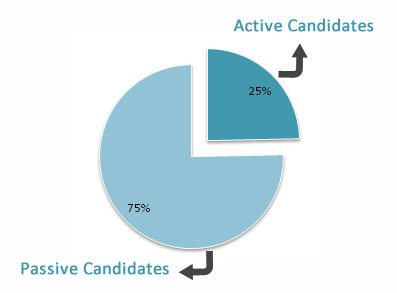We recently concluded a search for client who asked us to source passive executive level talent for a critical role in their organization. As an Executive Search Firm, it’s not unusual for a client to request us to hunt for successful people who are actively working in their industry and alert them to our client’s opportunity. And while there are very talented active job seekers who can be successful for a company, we were asked to hold this search in strict confidence which necessitated a passive talent search.
When interviewing a passive talent it’s important to remember the critical difference between active and passive talent. Namely this…
An Active job seeker is essentially asking you to help solve their challenge – their need to find a job. But when you are pursuing passive talent, you are essentially asking them to solve your challenge – helping your company move forward and thrive.
Which means the expectations of both the candidate and the client need to shift somewhat. Here are some helpful reminders when engaging and interviewing passive talent.
It’s a Two Way Street
The client needs to keep in mind that the passive talent is there to investigate and learn more about the opportunity. As such they’re interviewing the hiring team as much as the hiring team is interviewing them. While every organization wants a prospective team member to want to join the team, keep in mind that the passive talent who is currently successful with another of your competitors is not there to “prove themselves”. Have an open, substantive dialog about your challenges and see how they react; good talent will in essence begin to work on your problem before you hire them, and they’re likely to demonstrate that in the first interview.
Ask Intelligent Questions
“Gotcha” questions like “How many gas stations are there in the United States?” serve to do nothing other than empower the interviewer and diminish the candidate. Most top companies like Google have already announced a moratorium on their use. Questions that allow the passive candidate to truly show you how they “work out their think” are much more valuable. Citing a previous problem that your company has already solved and asking the candidate to elaborate on how they might have approached the problem will give a much clearer picture of the talent’s thought process. Or asking them to walk you through a challenge they solved at a previous position they held will yield better insight.
Answer the Tough Questions
An executive level passive talent will have done their homework before the interview. And they too should be asking pertinent and informative questions. If they ask a question that relates to a difficulty your team or company are having, answer it honestly. That doesn’t mean release proprietary or sensitive information, but dodging the question or switching the subject won’t help either. Be candid. Be direct. Top tier talent will understand and presumably be there as a part of the plan to solve those challenges. And they’ll respect a leader who is honest and direct.

